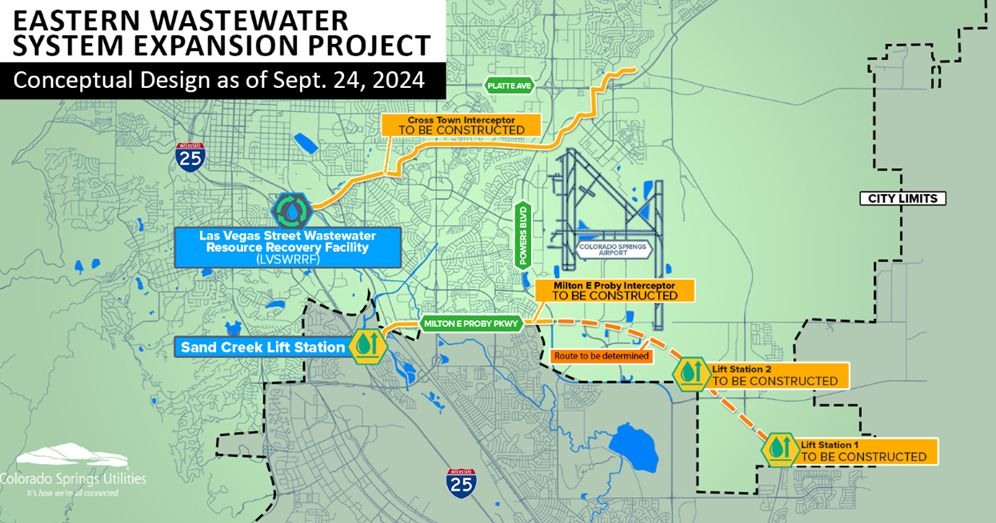This story has been updated to correct a spelling of Tristan Gearhart’s name and the rate increase that Utilities customers would pay in 2029.
Development on a $396 million expansion of Colorado Springs’ wastewater system on the east side of the city will begin later this year, with Colorado Springs Utilities covering the upfront cost.
The Colorado Springs Utilities Board reviewed the plans at its meeting Wednesday afternoon for the Eastern Wastewater System Expansion, which will build 18 miles of wastewater main lines and pump stations on the growing east side of Colorado Springs.
Utilities staff said the current wastewater system could reach its capacity on the east side as soon as 2028, which would prevent any more development in the area. The expanded system was projected to benefit around 225,000 customers in Colorado Springs.
Studies for different eastern improvements had taken place since 2019, with the final approval coming from the budget passed last year. Utilities will cover the initial construction cost with a combination of bonds and rate increases approved by the City Council last year, with developers paying recovery fees to join the system over the next several decades.
“There are times when it makes sense that Utilities would be the developer on a utility that benefits so much of the overall system,” Utilities Chief Financial Officer Tristan Gearhart said.
The first phase of the expansion involves building two long main lines across the eastern section of the city that feed into the Las Vegas Street Wastewater Resource Recovery Facility. One line would go north along Airport Road and U.S. 24 to the Cimarron Hills area. The other would go south of Colorado Springs Airport to the far southeast corner of the city boundaries.
Utilities staff said the design and land acquisition for the first phase would begin in June and continue through 2027. Construction would begin in 2027 and be completed by the end of 2030, with parts of the system coming online as they are built.
Other alternatives were considered, such as building a new wastewater treatment center near the south end of Banning Lewis Ranch or collaborating with Fountain to use that town’s treatment plant. Gearhart said building a new facility would not be eligible for rate recovery by developers and that other approaches would have more permitting time or construction cost.
The rate increases for the chosen project translate to about $23 extra in utility costs this year for the average Colorado Springs customer and would increase to $126 for residential customers by 2029. Gearhart said the five-year rate increase now would reduce the need for additional rate increases in the future.
“That’s the North Star for us — to take care of the current ratepayers and at the same time to allow development of a part of our city that is just stuck right now,” Utilities board chair and Councilmember Dave Donelson said.
Developers will still have to pay for the installation of service lines connecting to the Eastern Wastewater System Expansion, as well as cost recovery fees when they connect. According to the Utilities presentation, developers would pay $750 to $3,900 for a single-family home, depending on where they were built and how much of the new infrastructure would be used.
The sole comment against the development plan came from attorney and former state Sen. Bob Gardner. Gardner’s firm was retained by an unnamed ratepayer to investigate whether some or all of the expansion should be paid for upfront by Norwood Development as part of the 2018 annexation agreement for Banning Lewis Ranch.
The 2018 annexation agreement stated the Banning Lewis owners would “construct, at their expense, all wastewater collection mains and service lines” for the development. In a letter Gardner sent to the Utilities Board and the City Council earlier this month, he said the proposed system would connect to Banning Lewis and should therefore fall under that agreement.
“This raises serious concerns about whether favorable treatment has been granted to these property owners to the detriment of ratepayers without notice to either the ratepayers or the citizens and perhaps without the actual knowledge of the Council/Utilities Board,” Gardner wrote in the letter.
Gardner asked the Utilities Board to launch an independent review of how the system funding was determined and potentially require Banning Lewis Ranch to cover the initial costs. In the letter, Gardner said his client could bring a class-action lawsuit by ratepayers if they kept the current plan.
Utilities staff and other members of the public emphasized that the Eastern Wastewater System Expansion benefited businesses and developments beyond Banning Lewis Ranch. Several supporters of the project said that the system was needed for Colorado Springs Airport and Peak Innovation Park to expand.
“We cannot meet the need for utilities today when we show this as a prospect,” Colorado Springs Chamber & EDC President Johnna Reeder Kleymeyer said about Peak Innovation. “Not to be draconian, but our economic development efforts would be shut down.”
Marla Novak from the Housing & Building Association of Colorado Springs said she worked with developers from Banning Lewis Ranch, Karman Line and several other projects in the multiple workshops that Utilities held about the system. Novak said all the discussions since 2023 led to them agreeing with Utilities on the current plan.
The Utilities Board did not officially vote to approve the project but showed unanimous support for Utilities CEO Travas Deal to proceed.

